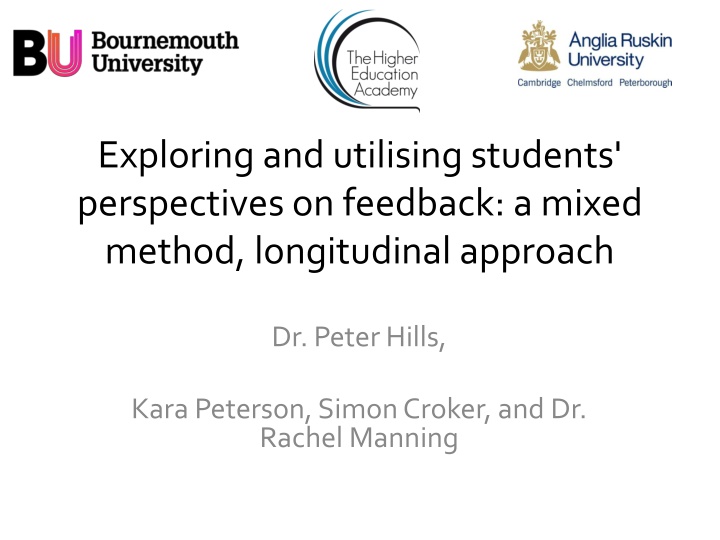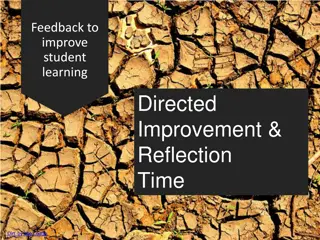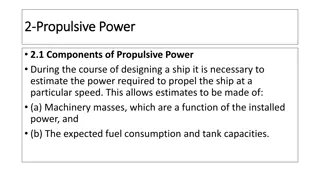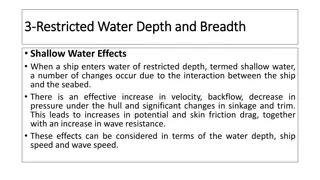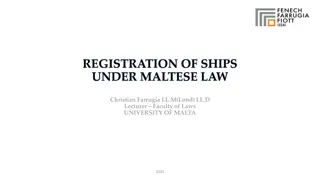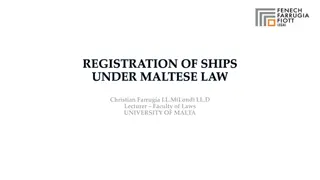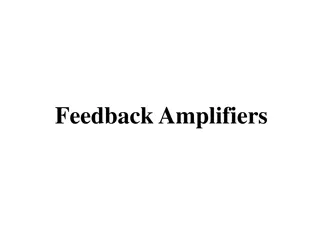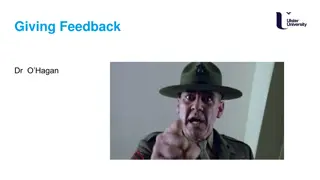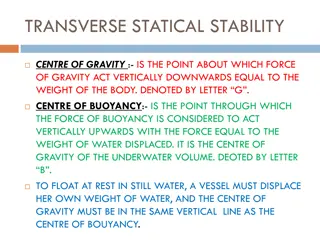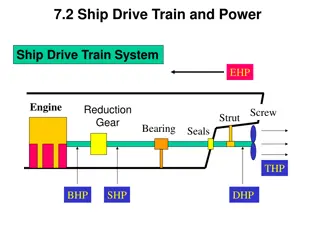Improving Academic Feedback: Turning the Ship with 1000 Students
Edinburgh medical school faces challenges in delivering effective feedback to students despite high overall ratings. To address this, a comprehensive study involving class-wide discussions, a large questionnaire, and the creation of the Edinburgh Feedback Inventory with over 1,000 student data points has been conducted. The inventory revealed students' dissatisfaction with current feedback practices, highlighting the importance of personalized and meaningful feedback. By tracking students' feedback satisfaction and academic performance, Edinburgh aims to implement tailored feedback strategies for student success.
Uploaded on Mar 01, 2025 | 2 Views
Download Presentation

Please find below an Image/Link to download the presentation.
The content on the website is provided AS IS for your information and personal use only. It may not be sold, licensed, or shared on other websites without obtaining consent from the author.If you encounter any issues during the download, it is possible that the publisher has removed the file from their server.
You are allowed to download the files provided on this website for personal or commercial use, subject to the condition that they are used lawfully. All files are the property of their respective owners.
The content on the website is provided AS IS for your information and personal use only. It may not be sold, licensed, or shared on other websites without obtaining consent from the author.
E N D
Presentation Transcript
Exploring and utilising students' perspectives on feedback: a mixed method, longitudinal approach Dr. Peter Hills, Kara Peterson, Simon Croker, and Dr. Rachel Manning
Project Timeline January 2013 Beginning of research February 2013 Conduct pilot focus groups March May 2013 Phase 1 focus groups and online survey June October 2013 Feeding forward on perceptions of feedback November 2013 February 2014 Phase 2 focus groups and online survey March April 2014 Evaluation of Project
Methodology Peer-led semi-structured focus groups Psychology undergraduates 40 phase 1 participants 19 phase 2 participants Participants from all three undergraduate years and a range of academic profiles
Methodology Online survey with open and closed response format Psychology students 98 phase 1 participants 78 phase 2 participants Participants from all three undergraduate years and a range of academic profiles
Survey Findings 7 6 5 Satisfaction Level 4 3 2 1 0 Overall Time to Get Feedback Amount of Feedback Codes Talking with Lecturers Aspects of Feedback Helping for Future Usefulness of Feedback Positive Feedback Negative Feedback Figure 1. Satisfaction levels with different aspects of feedback
Survey Findings 7 6 5 Satisfaction Level 4 3 2 1 0 Overall Time to Get Feedback Amount of Feedback Codes Talking with Lecturers Aspects of Feedback Helping for Future Usefulness of Feedback Positive Feedback Negative Feedback Figure 1. Satisfaction levels with different aspects of feedback
Survey Findings 7 6 5 Satisfaction Level 4 3 2 1 0 Overall Time to Get Feedback Amount of Feedback Codes Talking with Lecturers Aspects of Feedback Helping for Future Usefulness of Feedback Positive Feedback Negative Feedback Figure 1. Satisfaction levels with different aspects of feedback
Survey Findings 7 6 5 Satisfaction Level 4 3 2 1 0 Overall Time to Get Feedback Amount of Feedback Codes Talking with Lecturers Aspects of Feedback Helping for Future Usefulness of Feedback Positive Feedback Negative Feedback Figure 1. Satisfaction levels with different aspects of feedback
Survey Findings 7 6 5 Satisfaction Level 4 3 2 1 0 Overall Time to Get Feedback Amount of Feedback Codes Talking with Lecturers Aspects of Feedback Helping for Future Usefulness of Feedback Positive Feedback Negative Feedback Figure 1. Satisfaction levels with different aspects of feedback
Survey Findings 7 6 5 Satisfaction Level 4 3 2 1 0 Overall Time to Get Feedback Amount of Feedback Codes Talking with Lecturers Aspects of Feedback Helping for Future Usefulness of Feedback Positive Feedback Negative Feedback Figure 1. Satisfaction levels with different aspects of feedback
Survey Findings 7 6 5 Satisfaction Level 4 3 2 1 0 Overall Time to Get Feedback Amount of Feedback Codes Talking with Lecturers Aspects of Feedback Helping for Future Usefulness of Feedback Positive Feedback Negative Feedback Figure 1. Satisfaction levels with different aspects of feedback
Survey Findings 7 6 5 Satisfaction Level 4 3 2 1 0 Overall Time to Get Feedback Amount of Feedback Codes Talking with Lecturers Aspects of Feedback Helping for Future Usefulness of Feedback Positive Feedback Negative Feedback Figure 1. Satisfaction levels with different aspects of feedback
Survey Findings 7 6 5 Satisfaction Level 4 3 2 1 0 Overall Time to Get Feedback Amount of Feedback Codes Talking with Lecturers Aspects of Feedback Helping for Future Usefulness of Feedback Positive Feedback Negative Feedback Figure 1. Satisfaction levels with different aspects of feedback
Key Themes Convenience Continuing Dialogue Consistency
Convenience Yeah, I mean, it s a bit difficult when you don t know when to collect your work. I just read the e-mail. I haven t collected any of my feedback. I just use the emails and go from there. I think it should be easier to actually collect your essay. I never bother going to pick up my [feedback].... when you go there you re waiting in a queue to pick it up in a room
Convenience Figure 2. Percentage of students that collect feedback and how they use feedback.
Convenience It s really just long going through all the codes just to refer back to what they mean. I just leave it. You have to keep going back to check the different codes which takes ages. Yeah it s like you have to read it and then you have to go back to your other piece of paper that says what the code means, it s just long and you just feel like you can t be bothered to do it.
Continuing Dialogue Yeah I think [feedback] should be a lot more one on one I think that [feedback] is helpful in a way but at the same time it just tells you what you ve done wrong not where you can improve and that is a really big aspect that you have to kind of do better in the future rather then making the same mistakes over and over again
Continuing Dialogue If someone s marked your work that they marked a while back and they ve noticed that there is an improvement in something or, you know, they ve seen that your marks are different it would be nice to know that you have improved it this time rather then just be over looked It s more of a one way thing at the moment, whereas you just get the feedback and then your expected to do it yourself. I don t know whether it s my slackness or whatever, but I don t know who I m, not allowed to speak to, but I would never realised I could go to my personal tutor because they haven t marked it.
Consistency [Feedback] is quite mixed, like you either get three pages full of things that you could ve done better or you get a little blank box and something and sort of a few little hand annotations on the thing.. [Feedback] should be standardised but obviously because of the topic it might vary what comments we ll get written but I think if there was like a standard procedure for each topic then it might be a bit clearer I think personally I d want like bullet points at the start and then I d want like details throughout
Convenience Continuing Dialogue Consistency Communication
Differences in perceptions of feedback based on academic achievement and student engagement
Compared to students with higher grades, students with lower grades: Were less satisfied with feedback, r(91) = .19, p = .066. Were less satisfied with positive comments, r(91) = .18, p = .081. Felt feedback was less helpful for future work, r(90) = .21, p = .046. Were less likely to collect feedback, r(88) = .25, p = .019. Were less likely to speak to lecturers, r(87) = .22, p = .035. Felt that feedback mattered less to them, r(89) = .20, p = .058.
Compared to students with lower grades, students with higher grades: Felt that handwritten comments over typed comments showed that lecturers were more interested in their work, = .01, p = .011 Preferred annotations over codes, = .01, p = .001 Preferred to speak to lecturers about feedback rather than using codes, = .02, p < .001 Preferred to speak to lecturers about feedback rather than reading paragraphs, = .01, p = .007 Wanted all the comments on their work highlighted compared to students with lower grades whom wanted only a selected number of comments highlighted, = .01, p = .004
Linguistic Differences Lower Grade students: It s been good to a certain level, however, some of the feedback they give, erm the lecturers, if they sit and criticise we should have done they don t say how we could have improved it. [INT: Yeah] They just mention what we did wrong but they don t say what they would have preferred for us to do, so. I just think they should provide model answers for like if they do criticise then they should say, or they should write what they think would ve been a better answer to what, where I went wrong or something. Higher Grade students: I m satisfied with any feedback because if you don t get any feedback you don t know you re improving, if you re not being pointed erm where you ve gone wrong, how can you correct it? I don t always know, I mean some of it s really clear and I know exactly where to go and what to do to improve what they ve said.
Linguistic Differences Lower Grade students: It s been good to a certain level, however, some of the feedback they give, erm the lecturers, if they sit and criticise we should have done they don t say how we could have improved it. [INT: Yeah] They just mention what we did wrong but they don t say what they would have preferred for us to do, so. I just think they should provide model answers for like if they do criticise then they should say, or they should write what they think would ve been a better answer to what, where I went wrong or something. Higher Grade students: I m satisfied with any feedback because if you don t get any feedback you don t know you re improving, if you re not being pointed erm where you ve gone wrong, how can you correct it? I don t always know, I mean some of it s really clear and I know exactly where to go and what to do to improve what they ve said.
Other Differences 1/3 of students do not want all their mistakes highlighted. Students wanted M=5 comments highlighted (range 2-10). Students with higher grades tended to want all mistakes highlighted, = .01, p = .004
Feedback: What you told us Issues Raised by Students Feedback too generalised Specific and personalised feedback is more useful Lack of specificity in how and what to improve Doesn t recognise progress or improvements that have been made Confusion about who to talk to with questions about feedback
Whats new Coursework Feedback and Reflection Sheet New reflection sheet for you to fill out and paste to the end of your coursework (on VLE Coursework Guidance ) Gives you a role in deciding what type of feedback you receive Enables you to highlight how you have used previous feedback on your work, what areas you have found difficult, and grade targets Allows markers to give personalised feedback based on your coursework goals and how you have used previous feedback.
Changes Implemented If you would like to know more about the feedback process or discuss any feedback you have received previously, please contact your personal tutor whose details can be found on your E-Vision page.
Changes Implemented These are the things you did well: You could do the following things to improve your work in future:
GradeMark I like that we dont have to look through like this and find out what QM or whatever these codes mean. You can just get over it and it just says. I prefer that. It s a lot better. Reflection Sheet I also like that we can write when we want specific feedback on, which is helpful. Positive Comments I found my first year was more negative. I haven t felt that this time and that was important for me.
Continuing Dialogue Ill have to be honest and say I ve only had one feedback where I felt confident and knew what I needed to do to improve. Communication I think some people don t know where you can go so I think they need to reiterate that you can go see them other times. They just need to remind people. Consistency I found that this year there s quite a lot of inconsistencies. For one of my modules last semester there was a lot less feedback given to me on that when the other modules.
Recommendations: Student-focused Student Feedback Handbook What is feedback? How can I use my feedback? Where can I can more information on feedback? Will contain information on cover sheets and reflection sheets.
Recommendations: Staff-focused Staff Feedback Handbook Staff handbook was produced and given to all staff. Ensuring that it is used and kept up to date with any new changes.
Convenience Continuing Dialogue Consistency Communication
Questions Feel free to ask any unanswered questions
